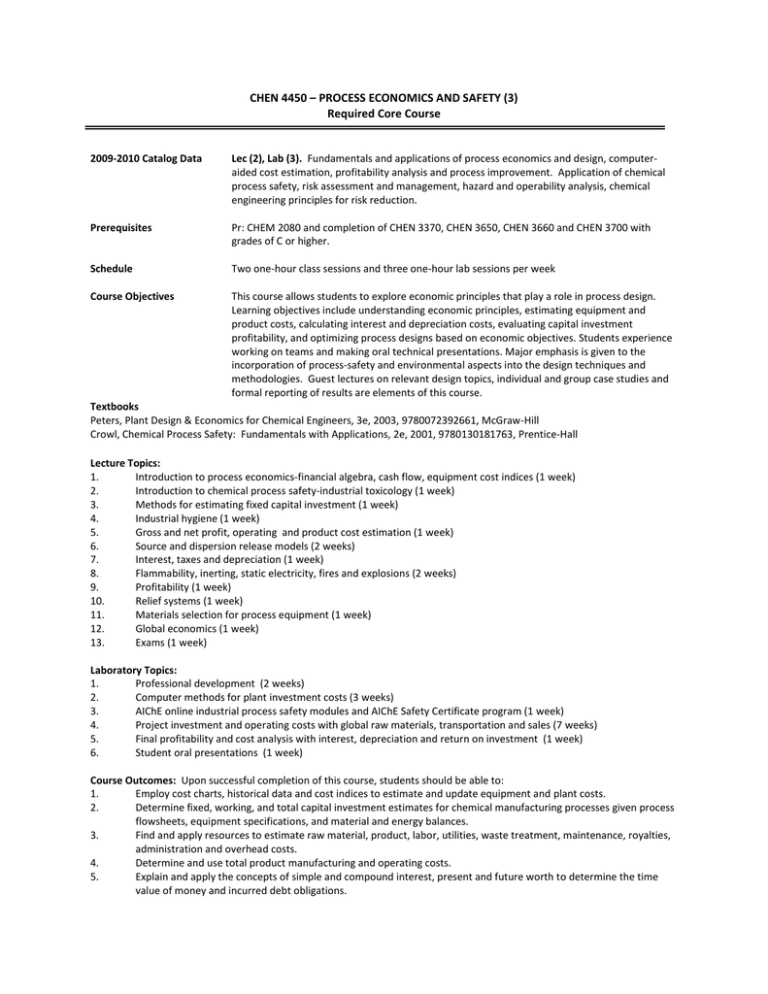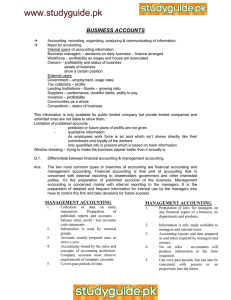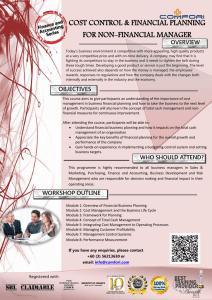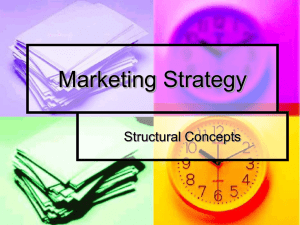CHEN 4450 – PROCESS ECONOMICS AND SAFETY (3) Required Core Course
advertisement

CHEN 4450 – PROCESS ECONOMICS AND SAFETY (3) Required Core Course 2009-2010 Catalog Data Lec (2), Lab (3). Fundamentals and applications of process economics and design, computeraided cost estimation, profitability analysis and process improvement. Application of chemical process safety, risk assessment and management, hazard and operability analysis, chemical engineering principles for risk reduction. Prerequisites Pr: CHEM 2080 and completion of CHEN 3370, CHEN 3650, CHEN 3660 and CHEN 3700 with grades of C or higher. Schedule Two one-hour class sessions and three one-hour lab sessions per week Course Objectives This course allows students to explore economic principles that play a role in process design. Learning objectives include understanding economic principles, estimating equipment and product costs, calculating interest and depreciation costs, evaluating capital investment profitability, and optimizing process designs based on economic objectives. Students experience working on teams and making oral technical presentations. Major emphasis is given to the incorporation of process-safety and environmental aspects into the design techniques and methodologies. Guest lectures on relevant design topics, individual and group case studies and formal reporting of results are elements of this course. Textbooks Peters, Plant Design & Economics for Chemical Engineers, 3e, 2003, 9780072392661, McGraw-Hill Crowl, Chemical Process Safety: Fundamentals with Applications, 2e, 2001, 9780130181763, Prentice-Hall Lecture Topics: 1. Introduction to process economics-financial algebra, cash flow, equipment cost indices (1 week) 2. Introduction to chemical process safety-industrial toxicology (1 week) 3. Methods for estimating fixed capital investment (1 week) 4. Industrial hygiene (1 week) 5. Gross and net profit, operating and product cost estimation (1 week) 6. Source and dispersion release models (2 weeks) 7. Interest, taxes and depreciation (1 week) 8. Flammability, inerting, static electricity, fires and explosions (2 weeks) 9. Profitability (1 week) 10. Relief systems (1 week) 11. Materials selection for process equipment (1 week) 12. Global economics (1 week) 13. Exams (1 week) Laboratory Topics: 1. Professional development (2 weeks) 2. Computer methods for plant investment costs (3 weeks) 3. AIChE online industrial process safety modules and AIChE Safety Certificate program (1 week) 4. Project investment and operating costs with global raw materials, transportation and sales (7 weeks) 5. Final profitability and cost analysis with interest, depreciation and return on investment (1 week) 6. Student oral presentations (1 week) Course Outcomes: Upon successful completion of this course, students should be able to: 1. Employ cost charts, historical data and cost indices to estimate and update equipment and plant costs. 2. Determine fixed, working, and total capital investment estimates for chemical manufacturing processes given process flowsheets, equipment specifications, and material and energy balances. 3. Find and apply resources to estimate raw material, product, labor, utilities, waste treatment, maintenance, royalties, administration and overhead costs. 4. Determine and use total product manufacturing and operating costs. 5. Explain and apply the concepts of simple and compound interest, present and future worth to determine the time value of money and incurred debt obligations. 6. 7. 8. 9. 10. 11. 12. 13. 14. 15. 16. 17. 18. 19. 20. 21. 22. 23. 24. 25. 26. 27. 28. 29. Apply straight-line and MACRS depreciation methods with appropriate IRS recovery periods to determine project depreciation. Calculate cash flow given sales income, operating costs, tax rates and depreciation. Calculate profitability measures including rate of return on investment, net present worth, payback period, and discounted cash flow rate of return. Apply modern financial analysis software, including ICARUS, to determine project profitability. Analyze capital investment profitability in relation to corporate savings rate and/or minimum acceptable rate of return. Apply both classical and modern financial analysis methods to sensitivity analysis of project profitability determining the effects of changes in raw material costs, plant size, process yields and royalties on profitability. Assess the effects of global raw materials availability and cost on project profitability including geopolitical stability and global economics. Apply probit analysis to determine the extent of damage from a causative variable. Locate and apply resources to estimate in-plant toxicological hazards including MSDS, TLV-TWA, PEL, etc. Determine worker exposures to toxic or corrosive vapors by material balances with diffusive and convective mass transport. Determine appropriate methods to control potential health hazards by process modification, enclosures, local and dilution ventilation, wet methods, enhanced housekeeping and personal protection. Apply source models to the release of liquid and vapor materials from holes or breaks in pipes, tanks and vessels. Apply neutrally buoyant dispersion and source models to the release of toxins outside the plant boundary using Pasquill-Gifford models at varying distances, wind speeds, atmospheric and ground conditions to determine the most probable highest risk scenarios. Find and apply toxic effect criteria for releases outside the plant boundary including ERPG, EEGL, Toxic Endpoint, etc. Determine upper and lower flammability limits for process vapor mixtures in air and in oxygen. Explain and employ flammability diagrams to determine limiting oxygen concentrations. Analyze explosions by calculating the energy of chemical explosions, the resulting overpressure and the effect of overpressure on structures at varying distances from the source in order to reduce potential damage. Determine methods to prevent fires and explosions through process modification, inerting, controlling static electricity, employing explosion-proof electrical housing and employing ventilation. Determine the proper relief guidelines and specify appropriate relief type. Determine sizes for liquid and vapor relief valves, flares and relief system knockout drums. Analyze the venting of process vessels during a fire situation (external to the vessel) by applying energy balances and source models to the design of vapor relief valves. Complete an on-line AIChE Safety Certificate on Safety in the Process Industries Module by Dr. Dan Crowl of Michigan Tech including corporate and lab safety, personal protective equipment, process area safety, DIERS, vent sizing, explosion experimental systems, and informal and formal safety reviews with study guide and on-line exam. Students must answer all questions correctly in order to receive a Safety Certificate. Deliver an effective individual oral presentation with appropriate visual aids explaining a team oriented profitability assessment project. Prepare an effective technical report for the project. Write an effective professional resume. Explain professional standards for interviews and other contacts with prospective employers. Contribution of Course to Meeting ABET Criteria 5 (Curriculum) Math and Basic Sciences Engineering Topics General Education 0 Credits 3 Credits 0 Credits Program Outcome Level of Coverage Relationship of Course to Program Outcomes (PO’s) A B C D E F G1 G2 H S R S S R S R S R Date of Preparation and Person(s) Preparing This Description February 6, 2010: Robert P. Chambers I R J S K S






